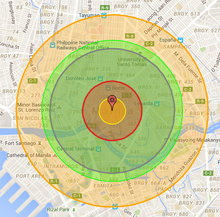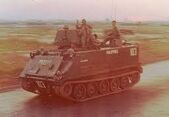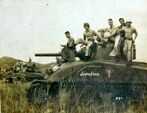Gillan1220 (talk | contribs) No edit summary Tags: Visual edit apiedit |
(Template) Tag: rte-wysiwyg |
||
| Line 23: | Line 23: | ||
=== 1963-1970s: Rebuild and Reconstruct === |
=== 1963-1970s: Rebuild and Reconstruct === |
||
| − | The first few weeks since the Great Nuclear War plunged the country into instability; further added by NPA insurgency. President Macapagal initiated long term plans to help stabilized the Philippines. First, he nationalized all branches of the armed forces and local law enforcement. U.S. military servicemen were integrated into the Philippine military for the time being. Troops were deployed into provinces to help distribute aid and quell riots. |
+ | The first few weeks since the Great Nuclear War plunged the country into instability; further added by NPA insurgency. President Macapagal initiated long term plans to help stabilized the Philippines. First, he nationalized all branches of the armed forces and local law enforcement. U.S. military servicemen were integrated into the Philippine military for the time being. Troops were deployed into provinces to help distribute aid and quell riots. |
All secessionists were made an enemy of the state such as the NPA. In Mindanao, another seccessionist group called the Moro National Liberation Front (MNLF) staged an insurgency, further giving a headache to the government. Filipino and American soldiers were deployed to Mindanao to quell and riots further. Because of the catastrophic event, the 1965 elections were suspended. Elections resumed in 1966, in which Macapagal lost to Ferdinand Marcos in a close election. Marcos then placed policies on how the country will move on from the Great Nuclear War. He declared that all communists, anarchists, and Islamic militants as enemies of the state. This was also the time that the Philippine Armed Forces saw increased recruits. The Citizens Army Training was made mandatory. Marcos would also initiate economic reforms in the country which made the Philippine's economy grow during this decade. |
All secessionists were made an enemy of the state such as the NPA. In Mindanao, another seccessionist group called the Moro National Liberation Front (MNLF) staged an insurgency, further giving a headache to the government. Filipino and American soldiers were deployed to Mindanao to quell and riots further. Because of the catastrophic event, the 1965 elections were suspended. Elections resumed in 1966, in which Macapagal lost to Ferdinand Marcos in a close election. Marcos then placed policies on how the country will move on from the Great Nuclear War. He declared that all communists, anarchists, and Islamic militants as enemies of the state. This was also the time that the Philippine Armed Forces saw increased recruits. The Citizens Army Training was made mandatory. Marcos would also initiate economic reforms in the country which made the Philippine's economy grow during this decade. |
||
| Line 34: | Line 34: | ||
=== The 1980s === |
=== The 1980s === |
||
[[File:13043440 1772610036291832 7361532160200947568 n.jpg|thumb|184x184px|Planting the Philippine Flag in Scarborough Shoal.]] |
[[File:13043440 1772610036291832 7361532160200947568 n.jpg|thumb|184x184px|Planting the Philippine Flag in Scarborough Shoal.]] |
||
| − | The Philippines strengthened their claims on the Spratly Island Archipelago. In 1981, the Philippines recognized Taiwan as the true China. This was done because there has been no word from Mainland China. It was also at this era when the Post-Marcos, new administration of the Philippine government decided to reach out both the NPA and MNLF as it saw no reason to continue fighting after the Great Nuclear War. |
+ | The Philippines strengthened their claims on the Spratly Island Archipelago. In 1981, the Philippines recognized Taiwan as the true China. This was done because there has been no word from Mainland China. It was also at this era when the Post-Marcos, new administration of the Philippine government decided to reach out both the NPA and MNLF as it saw no reason to continue fighting after the Great Nuclear War. |
=== 1990s === |
=== 1990s === |
||
| Line 63: | Line 63: | ||
== Culture == |
== Culture == |
||
| − | The culture is mixed with pre-Hispanic cultures, Malayo-Polynesian, Spanish, American and other Western cultures.{{GNW}} |
+ | The culture is mixed with pre-Hispanic cultures, Malayo-Polynesian, Spanish, American and other Western cultures.{{Template:GNW Asia}} |
| − | |||
[[Category:Countries (Great Nuclear War)]] |
[[Category:Countries (Great Nuclear War)]] |
||
[[Category:Philippines]] |
[[Category:Philippines]] |
||
Revision as of 18:04, 27 July 2016
| |||||
| Anthem | "Lupang Hinirang" | ||||
| Capital | Baguio City (de facto) | ||||
| Largest city | Davao City | ||||
| Other cities | Cebu, Zamboanga, Tacloban, Dumaguete, Bacolod | ||||
| Language official |
Tagalog | ||||
| others | Spanish, English, Bisaya, Chavacano, Waray-Waray | ||||
| Ethnic Groups main |
Tagalog | ||||
| others | Visayan, Igorot, Tausug, Ivatan, Malay, Chinese, American, Spanish | ||||
| Demonym | Filipino | ||||
| Government | Constitutional republic | ||||
The Philippines, officially the Republic of the Philippines (Filipino: Republika ng Pilipinas) is a sovereign island state located in Southeast Asia. The archipelago consists of 7,107 islands, divided into Luzon, Visayas, and Mindanao. It also controls Sabah. Despite Manila being targeted during the Great Nuclear of 1962, it was one the few nations to survive that catastrophic event.
History
Before WWIII
The Philippines was a Spanish colony for over 300 years before being ceded to the United States in 1898 following American victory during the Spanish-American War. A short-lived Filipino-American War was fought in which the Philippines became a U.S. territory in 1902. An Insular Government was established in the islands following this. The Philippines took one step closer to independence in 1934; the following year, the Commonwealth of the Philippines was established which would become independent in 10 years, with Manuel L. Quezon as President. The independence of the country was delayed because the Empire of Japan invaded the country in December 1941. In May 1942, the country was occupied by the Japanese. The United States returned to liberate the islands in October 1944 and was fully liberated in July 1945.
On July 4, 1946, the independence of the Republic of the Philippines came into effect. The United States maintained their military bases in the country in an agreement that would last another 99 years. During the outbreak of the Korean War in 1950, the Philippines took part in the United Nations forces in the defense of South Korea, where Filipino forces fought against the Chinese and the North Koreans. At the same time during the Korean War, the Hukbalahap (communist guerrillas who fought the Japanese during the Second World War) staged a communist rebellion which was crushed in 1954 when the leader Luis Taruc surrendered to government forces. The country signed a mutual defense pact with the United States in 1951.
As the 1960s entered, the Philippines continued to support the United States in its Cold War against communism worldwide. It was one of this reason why the country was targeted during World War III.
Great Nuclear War

Configuration of the Manila blast.
The capital of the Philippines, Manila, was struck with a 20kt Soviet nuclear weapon. It is estimated that 240,000+ people were killed instantly with another 490,000+ injured. Several more would be killed by radiation sickness in the weeks to come. Following the nuclear attack on Manila, the city and the nearby cities were evacuated to the surrounding provinces. President Diosdado Macapagal was warned ahead by the U.S. were he was evacuated to Baguio before the Soviet strike on Manila. The Philippine government relocated to Baguio City, Benguet which would become its temporary capital for the time being. The military was deployed to oversee the evacuation efforts as well as quelling riots. U.S. troops in the country, having lost contact with the Continental United States, decided it was the in their best interests to assist their Filipino allies in the evacuation and relief efforts. The evacuation would take over several weeks as Manila was declared a "No Entry Zone" guarded by both Philippine and American troops.
A New Communist Insurgency

NPA rebels in rural Luzon.
Although the Huks have ended their insurgency, a brewing movement of new communists revolutionaries called the New People's Army began attacking villages, police stations, and military outposts. The NPA, having heard of the Soviet attack on Manila, thought it was the right time to overthrow the Philippine government. Military units, backed up by U.S. forces, would be deployed to the jungles and farmlands around the country - quelling rebellions and destroying communist strongholds.

Philippine Army M113 APC with soldiers engaging the NPA in Central Luzon.
Soon after, it seemed like the Philippines would become the next Vietnam War as the communist insurgents launched a war of attrition against government forces. The military nonetheless continued their resolve to quell the insurgency. Besides American servicemen assisting the Filipinos, the local troops were often assisted by anti-communist groups and vigilantes.
1963-1970s: Rebuild and Reconstruct
The first few weeks since the Great Nuclear War plunged the country into instability; further added by NPA insurgency. President Macapagal initiated long term plans to help stabilized the Philippines. First, he nationalized all branches of the armed forces and local law enforcement. U.S. military servicemen were integrated into the Philippine military for the time being. Troops were deployed into provinces to help distribute aid and quell riots.
All secessionists were made an enemy of the state such as the NPA. In Mindanao, another seccessionist group called the Moro National Liberation Front (MNLF) staged an insurgency, further giving a headache to the government. Filipino and American soldiers were deployed to Mindanao to quell and riots further. Because of the catastrophic event, the 1965 elections were suspended. Elections resumed in 1966, in which Macapagal lost to Ferdinand Marcos in a close election. Marcos then placed policies on how the country will move on from the Great Nuclear War. He declared that all communists, anarchists, and Islamic militants as enemies of the state. This was also the time that the Philippine Armed Forces saw increased recruits. The Citizens Army Training was made mandatory. Marcos would also initiate economic reforms in the country which made the Philippine's economy grow during this decade.
Reclaiming Sabah
There were plans to capture Sabah by 1968, however this was delayed as Marcos was closely observing the situation with the Indonesia-Malaysia confrontation. The Great Nuclear War only made it worse as British forces were caught off guard. Before the end of the 1960's, the Marcos government had started manufacturing their own arms (using copies of U.S. made weapons), ships, and early ballistic missiles. By 1971, with the situation in Borneo gone out of control, the Philippines mounted an amphibious invasion of Sabah crossing from Tawi-Tawi in the pretext of "peacekeeping." This caught the Malaysian, British, and Indonesian soldiers off guard. The fighting became a free-for-all, as it was troops started firing on each other. For three years, the fighting became a stalemate and all leaders sued for peace. President Marcos met with the leaders of Malaysia, Indonesia, and the Commonwealth on discussions to end the conflict. This resulted in the formation of Malaysia and the cession of Sabah to the Philippines. Relations between the two would become frostly until the 1980s. President Marcos would serve for another term before stepping down.
In 1975, contact was established with the United States of the Pacific - the official successor of the former United States. Americans still in the Philippines were given the option to relocate or stay. A bulk portion decided to move back to the "America" that exists, moving to Guam, Hawaii, and the Trust Territory of the Pacific Islands. while a few decided to remain in the Philippines. As for U.S. military assets that were nationalized, the USP government decided to give it to the Philippines
The 1980s

Planting the Philippine Flag in Scarborough Shoal.
The Philippines strengthened their claims on the Spratly Island Archipelago. In 1981, the Philippines recognized Taiwan as the true China. This was done because there has been no word from Mainland China. It was also at this era when the Post-Marcos, new administration of the Philippine government decided to reach out both the NPA and MNLF as it saw no reason to continue fighting after the Great Nuclear War.
1990s
The country established ties with Zhusanjiao after a Philippine frigate docked in Hong Kong in 1992. The Filipinos were surprised to see that not only Hong Kong and Macau united, but has since controlled portions of southern China. The two nations began trading afterwards.
Government and Politics
Government
The Philippines has a democratic government in the form of a constitutional republic with a presidential system. The country follows the 1935 Constitution, the same one used when the Commonwealth of the Philippines was established in that year.
The President is the head-of-state and the head-of-government. He is also the commander-in-chief of the armed forces. The Congress is the legislative branch of the government. It is divided into the upper house (Senate) and the lower house (House of Representatives). Judicial duties are performed by the Supreme Court.
Foreign Relations
The Philippines is a member of the United Nations and the Southeast Asia Treaty Organization (SEATO). The country had close ties with the West, namely the United States, the United Kingdom, Australia, New Zealand, and West Germany. It is an ally of the United States since 1951 with the signing of the Mutual Defense Treaty, of which the United States of the Pacific (USP - the continuation of the USA in West Coast and the Pacific Ocean) would come to the defense of the Philippines. Following the Great Nuclear War, the Philippines has maintained relations with its neighboring countries such as Indonesia, Taiwan, Thailand, and South Vietnam. Relations with Malaysia are somewhat strained because of the Sabah Issue. Recently, the country has established ties with the Republic of Zhusanjiao (Pearl River Delta), further bringing trade to the former areas of mainland China.
Military

Philippine Army M4 Sherman tank.
The Armed Forces of the Philippines (AFP) is the military forces of the country. It is divided into three branches: Army, Air Force, and the Navy - of which the Marine Corps are part of. The standard service firearm is the M-16 assault rifle. They are used extensively with the M-14 rifle from the 1950s. In addition to that, the military still has remnant weapons and vehicles from World War II such as the M1 Garand, M1 Thompson, M3 Grease Gun, and countless leftovers from the Japanese occupation.
The Army operates M4 Shermans, M3 Half Tracks, Grayhound APCs, M113s, and still-operational, captured Type 95 and Type 97 IJA tanks.

A formation of PAF F-86 Sabre jets above Baguio City.
In its aircraft inventory, the Philippine Air Force mainly operates the F-86 Sabre. With the nationalizing of the U.S. military assets in the country, the country was able to acquire USAF F-4 Phantoms and Northrop F-5 tigers. Fighters planes from World War II are placed in reserve.
The Navy operates frigates, gunboats, and corvettes. They conduct joint patrols with the remnant U.S. Navy ships at Subic Bay.
Economy
The Philippines economy mainly relies on agriculture and fishing. The tropical climate makes it ideal to plant crops such as rice, corn, sugarcane, onion, garlic, and a variety of tropical crops. Fruits such as mangoes, durian, and pineapples, have also been exported to the nearby regions. It is known that the country is rich in natural resources but these have yet to be maximized as the Philippines has still to find the means to extract these.
Culture
The culture is mixed with pre-Hispanic cultures, Malayo-Polynesian, Spanish, American and other Western cultures.
| |||||||||||||||||||||||||
| |||||||||||||||||


